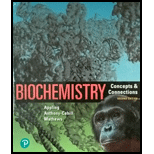
Concept explainers
(a) Interpretation:
The equilibrium constant for the given reaction and the maximum
Concept introduction:
The standard Gibbs free energy change,
Here, R is Universal gas constant and T is temperature.
For any equilibrium reaction as follows:
Equilibrium constant can be calculated as follows:
Here,
(b) Interpretation:
The maximum ratio of
Concept introduction:
The standard Gibbs free energy change,
Here, R is Universal gas constant and T is temperature.
For any equilibrium reaction as follows:
Equilibrium constant can be calculated as follows:
Here,
(c) Interpretation:
The conditions should be identified under which both the directions are favored in substrate cycle.
Concept introduction:
Substrate cycle is the cycle of phosphorylation & dephosphorylation which is catalyzed by two enzymes and the net effect is hydrolysis of adenosine tri phosphate which releases adenosine di phosphate, inorganic phosphate and heat generation.
(d) Interpretation:
Factors that control the direction of net conversion of substrate cycle such as in the cell should be identified.
Concept introduction:
Substrate cycle is the cycle of phosphorylation & dephosphorylation which is catalyzed by two enzymes and the net effect is hydrolysis of adenosine tri phosphate which releases adenosine di phosphate, inorganic phosphate and heat generation.
Want to see the full answer?
Check out a sample textbook solution
Chapter 11 Solutions
Biochemistry: Concepts and Connections (2nd Edition)
 BiochemistryBiochemistryISBN:9781319114671Author:Lubert Stryer, Jeremy M. Berg, John L. Tymoczko, Gregory J. Gatto Jr.Publisher:W. H. Freeman
BiochemistryBiochemistryISBN:9781319114671Author:Lubert Stryer, Jeremy M. Berg, John L. Tymoczko, Gregory J. Gatto Jr.Publisher:W. H. Freeman Lehninger Principles of BiochemistryBiochemistryISBN:9781464126116Author:David L. Nelson, Michael M. CoxPublisher:W. H. Freeman
Lehninger Principles of BiochemistryBiochemistryISBN:9781464126116Author:David L. Nelson, Michael M. CoxPublisher:W. H. Freeman Fundamentals of Biochemistry: Life at the Molecul...BiochemistryISBN:9781118918401Author:Donald Voet, Judith G. Voet, Charlotte W. PrattPublisher:WILEY
Fundamentals of Biochemistry: Life at the Molecul...BiochemistryISBN:9781118918401Author:Donald Voet, Judith G. Voet, Charlotte W. PrattPublisher:WILEY BiochemistryBiochemistryISBN:9781305961135Author:Mary K. Campbell, Shawn O. Farrell, Owen M. McDougalPublisher:Cengage Learning
BiochemistryBiochemistryISBN:9781305961135Author:Mary K. Campbell, Shawn O. Farrell, Owen M. McDougalPublisher:Cengage Learning BiochemistryBiochemistryISBN:9781305577206Author:Reginald H. Garrett, Charles M. GrishamPublisher:Cengage Learning
BiochemistryBiochemistryISBN:9781305577206Author:Reginald H. Garrett, Charles M. GrishamPublisher:Cengage Learning Fundamentals of General, Organic, and Biological ...BiochemistryISBN:9780134015187Author:John E. McMurry, David S. Ballantine, Carl A. Hoeger, Virginia E. PetersonPublisher:PEARSON
Fundamentals of General, Organic, and Biological ...BiochemistryISBN:9780134015187Author:John E. McMurry, David S. Ballantine, Carl A. Hoeger, Virginia E. PetersonPublisher:PEARSON





